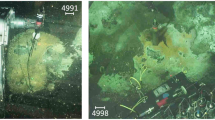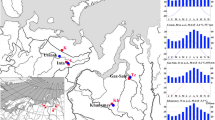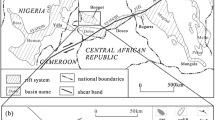Abstract
Gas-chromatographic and mass-spectrometric investigation of the saturated hydrocarbon fraction of a distillation cut of Thornton bitumen has revealed the presence of diastereomeric pairs of side-chain-extended 17α(H)-hopanes with carbon numbers ranging up to C40. Pentacyclic triterpanes of the hopane type are ubiquitous in sediments and related fossil fuels1. Commonly, besides the parent hydrocarbon itself, 17α(H)-hopane(C30), compounds with degraded (C27, C29) and extended side-chains (C31–C35) are detected2. While hopanes with 30 or fewer carbon atoms can easily be interpreted as diagenetic products of C30 hopanoids, for example, hop-22(29)-ene, known in several living organisms3, the extended hopanes (C31–C35) have recently been related to a C35 precursor, bacteriohopanetetrol, which was found to be a constituent of several microorganisms1,4–6. We report here that the new C36–C40 hopanes are of the same structural type as the well-known extended hopanes ranging up to C35.
This is a preview of subscription content, access via your institution
Access options
Subscribe to this journal
Receive 51 print issues and online access
$199.00 per year
only $3.90 per issue
Buy this article
- Purchase on Springer Link
- Instant access to full article PDF
Prices may be subject to local taxes which are calculated during checkout
Similar content being viewed by others
References
Ourisson, G., Albrecht, P. & Rohmer, M. Pure appl. Chem. 51, 709–729 (1979).
Van Dorsselaer, A., Albrecht, P. & Ourisson, G. Bull. Soc. chim. Fr. 165–170 (1977).
Arpino, P., Albrecht, P. & Ourisson, G. in Advances in Organic Geochemistry—1971 (eds von Gaertner, H. R. & Wehner, H.) 173–187 (Pergamon, Oxford, 1972).
Förster, H. J., Biemann, K., Haigh, W. G., Tattrie, N. H. & Colvin, J. R. Biochem. J. 135, 133–143 (1973).
Langworthy, T. A. & Mayberry, W. R. Biochim. biophys. Acta 431, 570–577 (1976).
Rohmer, M. & Ourisson, G. Tetrahedron Lett. 3633–3636 (1976).
Marschner, R. F., Duffy, L. J. & Winters, J. C. Trans Ill. State Acad. Sci. 68, 263–277 (1975).
Mackenzie, A. S., Patience, R. L., Maxwell, J. R., Vandenbroucke, M. & Durand, B. Geochim. cosmochim. Acta 44, 1709–1721 (1980).
Ensminger, A., van Dorsselaer, A., Spyckerelle, Ch., Albrecht, P. & Ourisson, G. in Advances in Organic Geochemistry—1973 (eds Tissot, B. & Bienner, F.) 245–260 (Editions Technip, Paris, 1974).
Quirke, J. M. E., Shaw, J. G., Soper, P. D. & Maxwell, J. R. Tetrahedron 36, 3261–3267 (1980).
Mackenzie, A. S., Quirke, J. M. E. & Maxwell, J. R. in Advances in Organic Geochemistry—1979 (eds Douglas, A. G. & Maxwell, J. R) 239–248 (Pergamon, Oxford, 1980).
Van Dorsselaer, A. thesis, Univ. Strasbourg (1975).
Ensminger, A. thesis, Univ. Strasbourg (1977).
Author information
Authors and Affiliations
Rights and permissions
About this article
Cite this article
Rullkötter, J., Philip, P. Extended hopanes up to C40 in Thornton bitumen. Nature 292, 616–618 (1981). https://doi.org/10.1038/292616a0
Received:
Accepted:
Issue Date:
DOI: https://doi.org/10.1038/292616a0
This article is cited by
Comments
By submitting a comment you agree to abide by our Terms and Community Guidelines. If you find something abusive or that does not comply with our terms or guidelines please flag it as inappropriate.



